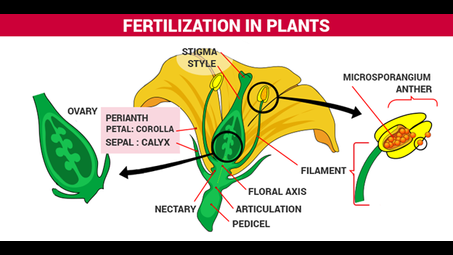In plants, fertilization is a process of sexual reproduction, which occurs after pollination and germination.
Fertilization can be defined as the fusion of the male gametes (pollen) with the female gametes (ovum) to form a diploid zygote. It is a physicochemical process which occurs after the pollination of the carpel. The complete series of this process takes place in the zygote to develop into a seed.
In the fertilization process, flowers play a significant role as they are the reproductive structures of angiosperms (flowering plants). The method of fertilization in plants occurs when gametes in haploid conditions fuse to produce a diploid zygote.
In the course of fertilization, male gametes get transferred into the female reproductive organs through pollinators (honey bees, birds, bats, butterflies, flower beetles) and the final product will be the formation of the embryo in a seed.
Fertilization Process
In flowers, the pollen grain germinates after the pollination of the carpel and grows into the style by creating the pathway for the pollen grain to move down to the ovary.
The pollen tube opens into the ovule through the micropyle and bursts into the embryo sac. Here, the male nucleus unites with the nucleus of an egg inside the ovule forming a diploid zygote, which later swells up and develops into a fruit.
Types of Fertilization
Fertilization process can be grouped into three types and are classified mainly based on the entry of the pollen tube into the ovule.
Porogamy
It is the common type of fertilization carried out in all angiosperms or flowering plants. In this type of fertilization, the pollen tube enters the ovule through the micropyle.
Chalazogamy
This type of fertilization is carried out on all Casuarina species of plants. In this condition, the pollen tube enters the ovule through the pollen tube.
Mesogamy
This type of fertilization is seen in all Cucurbit plants, such as pumpkin, ridge gourds, bitter gourd and other gourd plants. In this type of fertilization, the pollen tube enters the ovule through its middle part or through the integuments of the ovule.
Double Fertilization
Double fertilization is a process of fertilization characterized by the fusion of a female gametophyte with two male gametes. In this mechanism, one sperm cell fuses with the egg-producing zygote, and the other fuses with the two polar nuclei to make the endosperm. All angiosperm plants undergo double fertilization process.
Seed plants can go through the process of fertilization, when seedless plants cannot. If the seedless plants do go through fertilization they would require a flower for fertilization to occur.

Fertilization in plants is the process where male and female reproductive cells (pollen and ovule) fuse to form a zygote, which will develop into a new plant embryo. This process usually occurs after pollination, when the pollen is transferred to the stigma of the flower. Fertilization is essential for sexual reproduction in plants.
Add your answer:
How is fertilisitation in animals similar to fertilisation in plants?
ecause they r the same
What are the petals for on a plant?
My teacher told me that they're there to attract insects so fertilisation can take placeMy teacher told me that they're there to attract insects so fertilisation can take placeMy teacher told me that they're there to attract insects so fertilisation can take place
What happens to the ovary after fertilisation in plants?
After fertilization in plants, the ovary develops into a fruit while the ovules inside the ovary develop into seeds. The ovary walls thicken and ripen to protect and nourish the developing seeds.
What is the difference between parthenogenesis and parthenocarpy?
Parthenogenesis is a type of reproduction where an egg develops into an embryo without fertilization, typically in some invertebrates and plants. Parthenocarpy, on the other hand, is a phenomenon in which fruits develop without fertilization, leading to seedless fruit formation in plants.
What part of a plant swells after fertilisation to become fruit?
The plant's ovary .
Double fertilisation discovered by?
Sergei Navashin discovered double fertilisation in plants.
How is fertilisitation in animals similar to fertilisation in plants?
ecause they r the same
What is the difference between pollination and fertilisation in flowering plants?
their is a lot of difference. they are the steps of asexual reproduction.
What are the 2 kinds of fertilization?
The 2 fertilisation's are external fertilisation, or internal fertilisation. External fertilisation is the type frogs do.
What is the definition of fertilisation for kids?
Adding stuff to earth to make plants grow better.
When pigs reproduce two cells join together what is this process called?
fertilisation
Mosquito have internal fertilisation or external fertilisation?
external
What is the method of fertilisation for the butterfly?
They use internal fertilisation.
Does fertilisation comes before seed dispersal?
fertilisation first
When was Fertilisation of Orchids created?
Fertilisation of Orchids was created in 1877.
Does a chicken carry out external fertilisation or internal fertilisation?
internal
What are the two kinds of fertilizers?
The 2 fertilisation's are external fertilisation which the frog does, or internal fertilisation.
